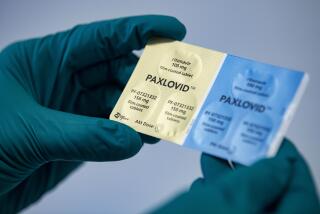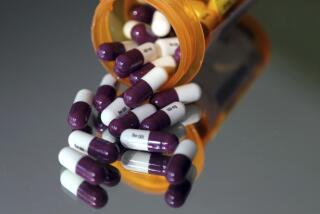New AIDS Hope Also Brings New Challenges
- Share via
CHICAGO — What a difference four years make.
In 1994, AIDS researchers met in Yokohama, Japan, under a very dark cloud. Drug treatments were failing, patients were dying and the future of the epidemic looked extraordinarily bleak.
But when many of the same researchers met here last week for the Fifth Conference on Retroviruses and Opportunistic Infections, they were facing an entirely different and much more satisfying set of problems: questions prompted by their great success in treating AIDS patients with highly effective combinations of drugs.
* Faced with more than 300 possible combinations of three or more drugs, which should they use in treating the newly infected?
* What can be done to help patients adhere to dosage regimens that now require taking handfuls of pills three times a day? Lack of adherence is one of the leading causes of treatment failure.
* Can the $15,000-per-year cost of the drugs be reduced?
* How serious are some of the long-term side effects that researchers are now beginning to see in patients who have been treated for two years or longer?
But those are questions that most do not mind confronting. “We have the luxury of talking about them because our patient population is doing so well,” said Dr. Paul Volberding of UC San Francisco. “It’s really clear that our palette [of treatment options] has expanded enormously.”
“Two years ago, we were turning a corner” with the use of new drugs such as the powerful protease inhibitors, said Dr. Roy Gulick of the Cornell University Medical Center. “Now we are fleshing out a lot of details.”
*
Physicians now have 11 approved drugs to choose from in treating AIDS patients or those who are HIV-positive. Seven of the drugs are so-called reverse transcriptase inhibitors, which block an enzyme that enables the virus to reproduce its genetic material. The other four are protease inhibitors, which block another enzyme crucial for viral replication. Four more drugs are expected to be approved by the Food and Drug Administration this year.
The most effective regimens have involved a so-called triple cocktail of two reverse transcriptase inhibitors and one protease inhibitor. “Group after group is showing that we can dramatically reduce hospitalizations and deaths” by reducing the concentration of HIV in the bloodstream to undetectable levels, Gulick said.
“It’s a bit of a quandary which drugs are best to start with,” said Dr. Scott Hammer of the Beth Israel Deaconess Medical Center in Boston. But the bottom line seems to be that the precise combination doesn’t really seem too important so long as the basic 2 + 1 regimen is used.
Some physicians prefer to use a cocktail without protease inhibitors for initial treatment, saving these more powerful drugs for “salvage” if the patient fails the first regimen, Hammer noted.
The cocktails of AIDS drugs do more than reduce the amount of virus in the blood, several researchers reported here. The drugs also allow the HIV-ravaged immune system to begin repairing itself, enabling it to stave off the opportunistic infections that are the normal cause of death for AIDS patients.
“In some patients, we are seeing almost a full restoration of their immune systems,” said Dr. Ashley Haase of the University of Minnesota.
The need to restore a damaged immune system might even be prevented if the patient is treated aggressively immediately after he or she is infected with the virus.
Early on in the infection, HIV knocks out the particular white blood cells, called helper cells, that serve to direct the body’s immune forces against the invading virus.
Suppressing HIV replication as soon as possible could head off this damage and leave patients with an immune system capable of fighting lower levels of HIV, according to Dr. Bruce Walker of Massachusetts General Hospital.
“This is absolutely the way we should go,” he said.
Despite the high price tag of combination therapy, “the cost-effectiveness is extremely high,” said Dr. Robert T. Schooley of the University of Colorado Health Sciences Center in Denver.
Schooley estimates that triple therapy costs about $7,200 for each year of life saved. By contrast, a coronary bypass is estimated to cost $100,000 per year of life saved and renal dialysis $50,000.
Health agencies that do not pay for AIDS therapy “have to come to grips with the fact that the savings [from reduced hospitalizations] completely or nearly completely offset the drug cost,” he said.
The AIDS drugs do have a downside. The drugs, particularly the protease inhibitors, produce a number of side effects, including nausea, diarrhea, headaches and other complaints. As many as 20% of HIV-positive patients fail therapy because they cannot tolerate those effects.
Now some patients who have been on therapy for one or two years are noting some potentially more consequential problems. Last summer, the FDA issued a warning that a small fraction of patients taking protease inhibitors have developed hyperglycemia (high blood sugar) or diabetes and cautioned physicians to be on the alert for symptoms.
Other patients have developed “buffalo humps” or “protease pouches,” unusual accumulations of fat on the abdomen, the back of the neck or even on their faces.
*
But most clinicians are not worried. Some patients have had surgery to remove the humps. But “if I were an AIDS patient and the drugs had reduced my viral load below detectable limits, I would not be too concerned about a hump,” said Dr. R.L. Hengel of Emory University.
Even diabetes is not interfering with the treatment, according to Toni Piazza-Hung of the FDA. “Most doctors continue the drugs and treat the diabetes with insulin or oral diabetes drugs,” she said.
But the symptoms may be indicators of more serious long-term changes in patients’ metabolism, physicians say. “We’re very concerned about the underlying metabolic problems,” Hammer said.
The second leading cause of failure, after side effects, is lack of adherence to treatment regimens that require handfuls of pills to be taken three times per day. Some pills interact poorly with one another or with food, so they must be taken at carefully prescribed times.
That point was reinforced by a study presented by Dr. Joseph P. Eron of the University of North Carolina Medical School at Chapel Hill. He compared 120 patients who received a cocktail of AZT, 3TC and a protease inhibitor to 120 who received the protease inhibitor and a drug called Combivir, which combines AZT and 3TC in a single capsule.
Although both groups were receiving the same dosages of the drugs, 96% of those receiving Combivir had undetectable levels of the virus at 16 weeks, compared to 72% of those receiving the more complicated drug cocktail.
“This data would at least suggest that the simpler dosing of Combivir contributed to better therapy adherence,” Eron said. Patients are more likely to take all their drugs if they only have to take two drugs at a time rather than three, he concluded.
Researchers have been searching for other ways to simplify dosages. Several scientists reported that twice-daily dosing of protease inhibitors is as effective as three times per day so long as the total daily dose is the same.
But not all efforts to simplify dosages with existing drugs have been successful.
Some researchers had hoped that once viral levels had been reduced by triple therapy, they could remove at least one of the drugs from the cocktail and maintain the low levels. Unfortunately, they reported, viral levels began rising almost immediately.
The best hope now is new drugs that are more powerful, longer lasting and perhaps simpler to take.
One example is DMP-266, or Sustiva, a Dupont-Merck drug that is expected to be approved later this year. This reverse transcriptase inhibitor requires only one daily dose.
Glaxo Wellcome has a new reverse transcriptase inhibitor called Abacavir that is effective in twice-daily dosages and has no adverse interactions with food or other drugs. Glaxo also has a new protease inhibitor called Amprenavir with similar characteristics. Both are expected to be approved this year.
*
Still further off, Abbott Laboratories has a new antiviral drug called ABT-378 that seems more powerful than existing drugs, with fewer side effects and simpler dosing. Pharmacia & Upjohn has a protease inhibitor called PNU-140690 that is also simpler to take and appears to be effective against viral strains resistant to the other four protease inhibitors.
“We want to get this simplified so that taking your AIDS pills becomes a part of your daily regimen, just like taking a vitamin or brushing your teeth,” said Dr. Eugene Sun of Abbott.
Another drug of the future is hydroxyurea, a leukemia and sickle cell drug that is being pressed into service against AIDS. Studies have shown that the inexpensive drug markedly improves the activity of the widely used AIDS drug ddI.
Perhaps the only gloomy news at the conference was the lack of progress toward an AIDS vaccine, which is universally viewed as the only prospect for controlling the AIDS epidemic in the rest of the world.
The most common approach that researchers have used is to attempt to stimulate immunity by inducing the body to produce antibodies against proteins found in the virus’ outer envelope. Researchers do this by vaccinating people with genetically engineered forms of the proteins. Those proteins seem to produce a strong immune response in humans.
But researchers have recently found, according to molecular biologist David Baltimore of Caltech, that antibodies produced by such experimental vaccines are directed at a part of the virus’ envelope that is not on the exterior, but hidden in the interior of the virus.
As a result, even if the antibodies are circulating in a person’s blood, they have no effect because their target is hidden.
Investigators using this approach may have to start over again. “If we had known this 10 years ago,” Baltimore said, “we would have gone in a completely different direction.”






